Archive for the ‘Science’ Category
Thursday, March 5th, 2015
The movie that forever changed my attitude to the future. – Michio Kaku
Forbidden Planet is a classic sci-fi movie about an alien society that has destroyed itself through technology and the scientist, Morbius, who discovers their secret. It shares elements with The Tempest except the movie uses science in place of the supernatural – the great Arthur C. Clarke’s maxim was that any advanced technology is indistinguishable from magic. The film’s science is plausible and the psychology even more so. I love this movie for the brilliant monster from the sub-conscious (designed by Disney animators); its set design; the first ever all-electronic score (by Bebe and Louis Barron); and the melodramatic script:
My evil self is at that door, and I have no power to stop it! – Morbius
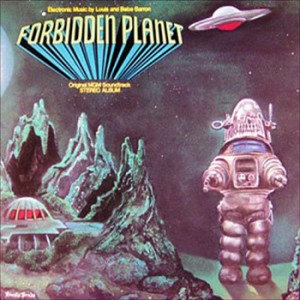
Tags: movies, science, science fiction
Posted in Sci-Fi, Science | No Comments »
Sunday, February 1st, 2015
A Bee in a Cathedral by Joel Levy is a fascinating book of science analogies and astonishing numbers. Suitable for all ages, only the physics section is a bit complex. A few of my favourites factoids:
- Every day 1 million meteoroids strike the Earth
- How far to the nearest star, Proxima Centauri? Travelling in a rocket at 250,000km/h, it would take you 18,000 years
- Most of the living cells in your body are less than a month old
- About 50 million neutrinos are passing through you now
- Every molecule in a glass of water is changing partners billions of times a second.
- How hard does your heart pump blood? Empty a bathtub in 15 minutes using only a teacup —repeat this without stopping for the rest of your life
- If an atom were blown up to the size of a cathedral, the nucleus would be no larger than a bee buzzing about in the centre.
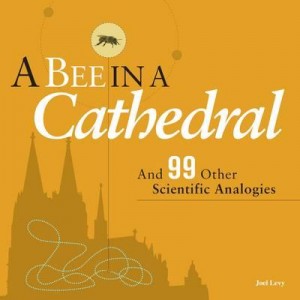
Tags: books, honey bees, reviews, science
Posted in Bees, Book Reviews, Science | No Comments »
Sunday, January 11th, 2015
Male bees (drones) have a decadent life inside the hive but it ends gruesomely. In spring and summer drones spend their days eating and sleeping – the female bees even clean up their droppings for them. In autumn the females push most of the drones out of the beehive to die in the cold air. Why have drones at all? To mate with a new queen, but it only happens once every few years. Several drones will mate with her and die in the act. Drones themselves have no father; they hatch from unfertilised eggs. It was once thought all bees came from virgin births, until in 1788 a blind Swiss naturalist, Francois Huber, proved that queens mated.
What big eyes the drones have; all the better to find the queen.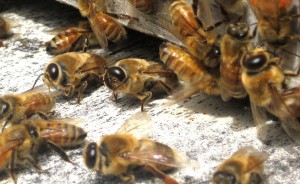
Tags: honey bees, science
Posted in Bees, Gardening, Science | No Comments »
Sunday, December 21st, 2014
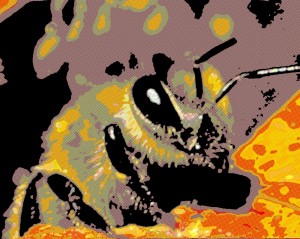
Honey bees have six (girl) powers to match any comic-book super hero. And like every super hero bees have one fatal weakness: when a bee stings you, it dies.
1. Super Flyers
Like Superman, bees are great flyers. A bee flies about 1000 km in her life. If she was human sized, that’d be like going five times around the planet. And she can carry 122 times her own weight.
2. Super Attractors
Like Magneto, honey bees use electro-magnetic forces. They have their own navigational GPS thanks to millions of magnetic crystals that sense the Earth’s magnetic field. Bees also have an electrical charge which attracts pollen.
3. Super Therms
Like Torch and Mr Freeze, bees cope with extreme temperatures. In the heat, air-conditioner bees fan their wings to cool the hive; and in the cold, bees huddle in a tight ball and shiver to keep warm.
4. Super Smarts
Like Professor X, bees are intelligent communicators. They are the only other creatures we know that use a symbolic language. The bee dance indicates direction and distance to flowers, and the quality of nectar. Bees can also tell time, measure, memorize, and solve problems.
5. Super Food
Like Wolverine, bees have healing powers. Honey is nutritious, lasts forever, and is a healer, killing bacteria and fungi. Manuka honey fights infection and heals burns. Bees use anti-bacterial propolis to keep their hives germ-free.
6. Super Transformers
Like Spiderman, bees can change their genetic structure. A queen bee is not born that way – any girl bee can become a queen. The worker bees prepare a royal baby by feeding it on royal jelly which triggers DNA change.
Tags: comics, honey bees, science
Posted in Bees, Science | No Comments »
Saturday, September 13th, 2014
New genetic research suggests honey bees originated in Asia not Africa as previously thought. Bees have been around for a while: the oldest known bee is a 100 million year old bee suspended in a piece of amber (a tree resin), found in Myanmar (Burma). Ancient bees lived in trees or on cliffs – honey bees derived from cavity-nesting bees that spread out from Asia about 300,000 years ago. People discovered honey about 20,000 years ago; it must’ve seemed like a magical food in their diet of wild animals and plants. Early honey hunting was a dangerous job because bees lived in tall trees or on cliff faces. Cave paintings show hunters climbing cliffs to raid nests – imagine dangling from a vine, 150 metres up a cliff, while being stung by bees! People still do this kind of honey hunting today in India, Nepal, Malaysia and Indonesia.
Image: Rock painting of a honey hunter in Valencia, Spain (6000 to 8000BC)

Tags: food, honey bees, science
Posted in Bees, Science | No Comments »
Sunday, August 10th, 2014
Does the universe have a purpose or is it an accident? Scientists have divergent views on the significance of the universe. At one end of the spectrum is the iconoclast, Richard Dawkins, who sees an indifferent universe which has “precisely the properties we should expect if there is at bottom no design, no purpose.” At the other end is biologist Jane Goodall who believes the universe is both purposeful and meaningful. In between there are theories ranging from a ‘conscious universe’ to a ‘self-creating universe’. Whatever their beliefs, at least there’s usually a shared sense of wonder among scientists…
…Read the rest of my essay, Science and Soul, here.
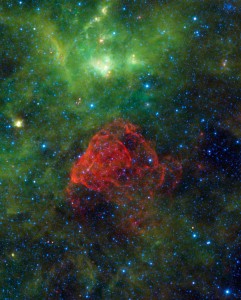 Photo: The remnants of supernova explosions, Puppis and Vela, birthplace of some of our atoms. Image courtesy of NASA/JPL-Caltech/UCLA
Photo: The remnants of supernova explosions, Puppis and Vela, birthplace of some of our atoms. Image courtesy of NASA/JPL-Caltech/UCLA
Tags: connections, consciousness, science, Universe
Posted in Science, Universe | No Comments »
Sunday, August 3rd, 2014
The threat to nature is the same as that once posed by the notorious chemical DDT.– BBC News
A new study on ‘neonicotinoid’ pesticides says that they are a key factor in the decline of bees. The study combined 800 research papers from 20 years and concluded these nicotine-based nerve poisons are also damaging the wider environment. The pesticides are systemic – the whole plant remains toxic right through to flowering – so bees (and other critters) are poisoned by pollen, nectar, and drinking water. These pesticides are widely used in NZ and even sold in garden centres. The government has not yet responded to the new study, so meanwhile, avoid these products: Confidor, Advantage, Merit and Admire (what shameless names). And remember that there are ways to deal with pests without harming bees, including organic gardening and IPM:
It is high time we returned to Integrated Pest Management (IPM) – an approach focussed on minimising pesticide use, maximising the number of biological control agents, using cultural controls such as crop rotations, and monitoring pest numbers so that chemical controls only need be applied when there is a problem.– Prof David Goulson
Tags: Gardening, honey bees, pesticides, science
Posted in Bees, Gardening, Science | 1 Comment »
Saturday, July 19th, 2014
Honey bees and flowers have an electric relationship. A bee in flight becomes positively charged through friction with airborne particles. Fortuitously, flowers have a negative electric charge – and naturally, positive and negative attract each other. The bee (+) detects the tug of the flower charge (-) and lands on it. Immediately two things happen. Firstly, charged pollen leaps onto the bee’s body, a bit like your hair will leap onto a rubbed balloon. Secondly, the flower loses its negative charge – this tells nearby bees that this flower has just been visited. The flower has time to ‘recharge’ itself and refill its nectary. It’s a sweet friendship: bees get food (pollen, nectar) and flowers get pollinated.

Tags: honey bees, science
Posted in Bees, Science | No Comments »
Sunday, December 15th, 2013
Honeycomb is one of the lightest, strongest, most efficient structures known. The comb isn’t just for honey, it’s the bee’s home: kitchen, nursery, pantry, bedroom and dance floor. Bees build these beautiful wax hexagons from flakes of wax (made in glands on their bellys) using their mouth and feet. Each identical cell tilts back at an angle of exactly 13˚ (so honey doesn’t flow out) and cells are joined at precisely 120˚. Bees use hexagons (not squares or triangles) because they use the least wax for the most space – hexagons are found elsewhere in nature where an efficient shape is needed.
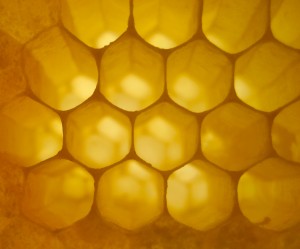
Tags: honey bees, science
Posted in Bees, Science | No Comments »
Friday, November 1st, 2013
‘Neonicotinoids’ … a clunky word, but one that everybody should know. They (‘neonics’ for short) are the most widely used insecticides in the world – they’re now found in almost every managed landscape from farms to home gardens (and use is increasing rapidly). Neonics are non-targeted (ie.lazy) pest control: they’re usually coated on seeds and the poison stays in the plant as it grows. And the residue can remain in plant tissue, pollen, soil and water for years – it’s these residues that can kill beneficial wildlife: bees, birds, soil creatures and helper insects. That makes neonics a threat to our food supply because:
- Bees and other pollinators directly provide much of our food
- Soil creatures (worms, microbes) are vital for soil health
- Helper insects (predatory and parasitic species) provide natural pest control
Why would we want to harm any of these? The EU has put a two year ban on neonics (because of damage to bees)but they are still used in NZ and are available to the public. Let’s ask garden and hardware shops to stop selling them (Placemakers and The Warehouse have recently withdrawn them) and the EPA to ban them.
Research: neonicotinoids harming honey bees
Report: effect of neonicotinoids on beneficial insects.
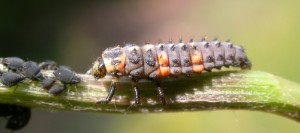 The larval stage of a ladybird (right) loves to eat aphids (left) – great natural pest control.
The larval stage of a ladybird (right) loves to eat aphids (left) – great natural pest control.
Tags: connections, food, Gardening, honey bees, science
Posted in Bees, Science | No Comments »
Thursday, September 19th, 2013
In the 1960s, Jane Goodall was criticised for saying chimpanzees have emotions. Today the evidence suggests she’s right although scientists remain wary of anthropomorphism – associating human traits with animals – often with good reason (eg. the gross inaccuracy of The Bee Movie in which boy bees did the work). Of course animals don’t see the world exactly we do, but we shouldn’t ignore what we have in common with them:
Anthropo-denial: A blindness to the humanlike characteristics of other animals, or the animal-like characteristics of ourselves. – F. de Waal
The weight of scientific evidence is that animal have thoughts, feelings and intelligence – animals are not mere ‘survival machines’. It’s now accepted that humans and animals share many traits (Marc Bekoff (The Emotional Lives of Animals); this fits nicely with evolution which teaches us animals are our relatives and all life is connected. Forgetting this relationship has led to the honey bee crisis, for example, as people have treated bees as tools rather than partners in pollination.
Acknowledged as individuals, those sparrows, salamanders and squirrels are not interchangeable parts of a species machine. They are beings with their own inner lives and experiences. – Brandon Keim (Animal Consciousness)
Using language that reflects our ‘common ground’ can help give children empathy with the natural world. When writing Flight of the Honey Bee I wanted accurate science yet also a sense of a bee’s experience. Should I use human concepts such as ‘know’, ‘remember’, captivate’, and ‘story’? Should I even call the bees ‘sisters’? The answer was yes. Honey bees have language, intelligence, and memory (and maybe something like emotions); and they’re more genetically sisters than humans.
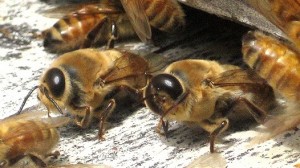
They are not us, but to look into their eyes is to know that someone is in there. Imposing our own specific thoughts and feelings on that someone is in one sense too imaginative, in presuming he could receive the world in the way we do, and in another not imaginative enough, in not opening our minds to the full possibilities of his difference.- Caitrin Nicol (Do Elephants Have Souls?)
Tags: connections, honey bees, science, writing
Posted in Bees, Science, Writing | 2 Comments »
Tuesday, April 30th, 2013
This is a victory for the precautionary principle, which is supposed to underlie environmental regulation.– Dr Lynn Dicks
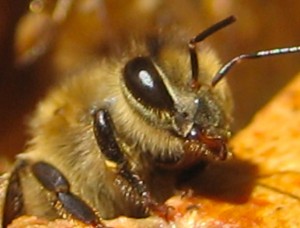 The EU has banned the nerve agent that has been contributing to honey bee decline around the world. The scientific evidence against these extremely toxic nicotine-based pesticides has grown steadily. Honey bees have contributed to our survival for the past 20,000 years and it’s time we showed them similar courtesy. These banned pesticides are still widely used on NZ crops (eg.corn) and sold to the public in garden centres (eg. the Confidor brand). Bee photo by Sophie Huber.
The EU has banned the nerve agent that has been contributing to honey bee decline around the world. The scientific evidence against these extremely toxic nicotine-based pesticides has grown steadily. Honey bees have contributed to our survival for the past 20,000 years and it’s time we showed them similar courtesy. These banned pesticides are still widely used on NZ crops (eg.corn) and sold to the public in garden centres (eg. the Confidor brand). Bee photo by Sophie Huber.
There are other way to deal with pests without harming bees:
It is high time we returned to Integrated Pest Management (IPM) – an approach focussed on minimising pesticide use, maximising the number of biological control agents, using cultural controls such as crop rotations, and monitoring pest numbers so that chemical controls only need be applied when there is a problem.– Prof David Goulson
Tags: honey bees, science
Posted in Bees, Gardening, Science | No Comments »
Sunday, January 6th, 2013
Why Does The World Exist? by Jim Holt is a fascinating book that asks the question, ‘Why is there something rather than nothing?’ Holt looks at all sides of the question, interviewing scientists, philosophers, atheists and believers (Richard Swinburne, John Irving, Roger Penrose, Adolf Grunbaum…). There are three types of theorist:
The “optimists” hold that there has to be a reason for the world’s existence and that we may well discover it. The “pessimists” believe that there might be a reason for the world’s existence but that we’ll never know for sure… Finally, the “rejectionists” persist in believing that there can’t be a reason for the world’s existence, and hence that the very question is meaningless.
Leibniz’s Principle of Sufficient Reason says that ‘For every thing there must be a reason for that thing’s existence‘, which is the basis of our scientific worldview. Holt does a good job of summarizing some knotty philosophy, physics and maths (understanding it is another matter!). Although he offers no firm answers, the book left me feeling “optimistic”; and it’s oddly comforting that after picking the brains of the world’s greatest thinkers, Holt concludes,
No one can confidently claim intellectual superiority in the face of the mystery of existence.
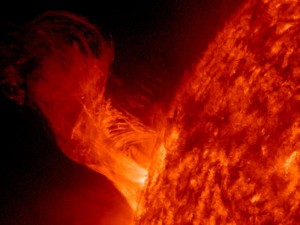
Photo: Solar eruption, Dec 31, 2012 – courtesy of NASA Images
Tags: books, connections, reviews, science, Universe
Posted in Book Reviews, Science, Universe | No Comments »
Monday, December 17th, 2012
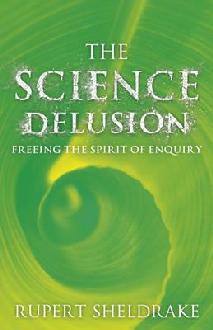 The Science Delusion by rebel scientist Rupert Sheldrake challenges the current scientific dogma that life is mechanical and purposeless. His chapters ask: “Are the laws of nature fixed? Is nature purposeless? Are minds confined to brains?” The title is a bit misleading but perhaps it’s a dig at Richard Dawkins (of ‘God Delusion’ fame), who describes living things as ‘machines’. The US edition title is Science Set Free, and it’s Sheldrake’s aim to break free from rigid materialistic science. Anyone who has ever had a pet, kept bees or grown a tree, knows that plants and animals are living organisms with a sense of purpose, not just an assembly of chemicals:
The Science Delusion by rebel scientist Rupert Sheldrake challenges the current scientific dogma that life is mechanical and purposeless. His chapters ask: “Are the laws of nature fixed? Is nature purposeless? Are minds confined to brains?” The title is a bit misleading but perhaps it’s a dig at Richard Dawkins (of ‘God Delusion’ fame), who describes living things as ‘machines’. The US edition title is Science Set Free, and it’s Sheldrake’s aim to break free from rigid materialistic science. Anyone who has ever had a pet, kept bees or grown a tree, knows that plants and animals are living organisms with a sense of purpose, not just an assembly of chemicals:
All living organisms show goal-directed behaviour. Developing plants and animals are attracted towards developmental ends…Even the most ardent defenders of the mechanistic theory smuggle purposive organising principles into living organisms in the form of selfish genes and genetic programs.– Rupert Sheldrake
Even the smallest entities seem to have a form of consciousness. He describes remarkable single-celled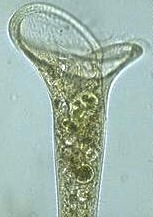 swamp creatures, called Stentor (photo), which have a memory despite having no nerve endings (synapses). Sheldrake writes most lucidly about science and philosophy, and he’s not afraid to theorise about fringe science events (which he explains with his rather cryptic theory of ‘morphic fields’). Read a review.
swamp creatures, called Stentor (photo), which have a memory despite having no nerve endings (synapses). Sheldrake writes most lucidly about science and philosophy, and he’s not afraid to theorise about fringe science events (which he explains with his rather cryptic theory of ‘morphic fields’). Read a review.
Tags: consciousness, reviews, science
Posted in Book Reviews, Science | 2 Comments »
Friday, March 23rd, 2012
The imagination of the good artist or thinker produces continuously good, mediocre, and bad things, but his judgment, trained and sharpened to a fine point, rejects, selects, connects… All great artists and thinkers [are] great workers, indefatigable not only in inventing, but also in rejecting, sifting, transforming, ordering. Nietzsche
Imagine, a new book by Jonah Lehrer – author of Proust was a Neuroscientist – is about creativity and the brain. Lehrer believes that creativity is our natural state and, like Neitzsche, he stresses the role of synthesising:
The synthesizing mind takes information from disparate sources, understands and evaluates that information objectively, and puts it together in ways that make sense… the capacity to synthesize becomes ever more crucial as information continues to mount at dizzying rates.
Perhaps synthesising is another word for the endless mulling, rewriting and editing that writers go through. David Ogilvy was one of the original 1960s ‘ad men’ referenced in TV’s Mad Men. He described the creative process of writing advertising copy as ‘a slow and laborious business’ of redrafting and editing (read his full letter here).
Does the ‘dizzying’ internet make us more creative? In a fascinating essay about the brain and computers, Jim Holt argues that while the internet sharpens many cognitive skills, it may be the enemy of creativity. The problem is that the web can be distracting (rather than reflective) for the brain and it barely engages with deeper levels of thought. Holt calls Google a ‘memory prosthesis’. That might be true but it does make synthesising a blog a lot of fun.
Talent develops in tranquility. Goethe
More: editing; and writing and computers
Tags: brain, writing
Posted in Science, Writing | No Comments »
Tuesday, March 20th, 2012
Dark matter is the missing link.Stuart Clark
Our universe exploded into being about 14 billion years ago, for motives which are unclear. Equal amounts of matter and anti-matter were made but most of the anti-matter mysteriously disappeared. And so the universe became biased towards life (matter). But only a ‘mere- smear’ of the universe is Normal Matter – that’s the atoms in stars, planets, you and me – the bulk is dark stuff.
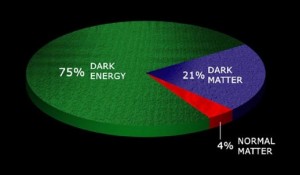
This pie (Image: NASA/CXC/M.Weiss) shows the ingredients of the universe. Most of it is Dark Energy that hides in the vacuum of space. We don’t yet know what it is, but it’s made the universe expand. Dark Matter is made of particles that are also invisible to us but we can see galaxies being affected by its force. The smallest slice of the universe is Normal Matter. Matter is built up from extremely small bits to extremely big bits: from inner space to outer space. Sub-atomic particles are arranged into atoms, atoms into molecules; molecules into cells and organisms; and so on up to galaxies and dark stuff. Everything belongs.
We exist only because of subtle connections between the very small and the very large. Charles Birch
Tags: connections, science
Posted in Science, Universe | No Comments »
Sunday, January 22nd, 2012
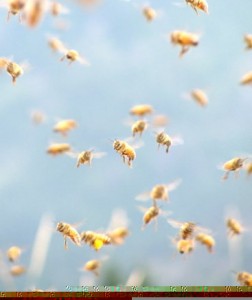 The latest on the pesticide threat to bees (see Nicotine Bees) is a small victory: a garden supplier has removed the words ‘low toxic to beneficial insects’ from an advertisement for Confidor. This pesticide is extremely toxic to the world’s most beneficial insect, the honey bee. These nicotine-based pesticides are banned in Europe because of links to bee deaths. They stay in the plant right through to flowering – so bees are poisoned by pollen, nectar, dust, and water. Latest research shows how the pesticides contribute to the bee crisis by exposing bees from multiple sources. Photo: Sarah Anderson.
The latest on the pesticide threat to bees (see Nicotine Bees) is a small victory: a garden supplier has removed the words ‘low toxic to beneficial insects’ from an advertisement for Confidor. This pesticide is extremely toxic to the world’s most beneficial insect, the honey bee. These nicotine-based pesticides are banned in Europe because of links to bee deaths. They stay in the plant right through to flowering – so bees are poisoned by pollen, nectar, dust, and water. Latest research shows how the pesticides contribute to the bee crisis by exposing bees from multiple sources. Photo: Sarah Anderson.
5 Ways to Save the Bees:
- Avoid chemicals such as Confidor, Poncho, Advantage, Marathon, Merit and Admire (grotesque names).
- Buy local honey.
- Grow bee-friendly plants, such as lavender.
- Let there be weeds; let the broccoli go to seed.
- Put out clean water in a shallow dish.
Tags: Gardening, honey bees, pesticides, science
Posted in Bees, Gardening, Science | No Comments »
Tuesday, August 30th, 2011
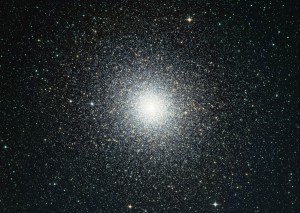 Nga ra o mua is a Maori phrase for the past; translated as ‘what is in front’. The past is spread out in front of us – it’s what is known. It’s literally true when we look at the stars: the light we see left the stars perhaps millions of years ago. The past is spread out in the sky. Nga ra o mua also fits the physics concept of a universe in which all points of time exist together. For example, about now on August 30, 1871, Ernest Rutherford is being born. It also explains why it’s hard to leave the past behind. Pam Morrison wrote eloquently about this in her blog. Photo: a million stars (NASA Images)
Nga ra o mua is a Maori phrase for the past; translated as ‘what is in front’. The past is spread out in front of us – it’s what is known. It’s literally true when we look at the stars: the light we see left the stars perhaps millions of years ago. The past is spread out in the sky. Nga ra o mua also fits the physics concept of a universe in which all points of time exist together. For example, about now on August 30, 1871, Ernest Rutherford is being born. It also explains why it’s hard to leave the past behind. Pam Morrison wrote eloquently about this in her blog. Photo: a million stars (NASA Images)
Tags: science, Universe
Posted in Science, Universe | No Comments »
Monday, July 25th, 2011
‘Tell all the Truth but tell it slant. Emily Dickinson
There’s talk of compulsory laptops and iPads for primary schools, but evidence suggests that books should be the priority for children. A good novel is more likely to engage the brain than a screen. Reading is a ‘neuronally and intellectually circuitous act’ (Maryanne Wolf) – or to put it another way, a novel encourages the reader’s brain to be active in the construction of the story. Wolf also argues that more indirect the writing the more enriching it is for the brain.
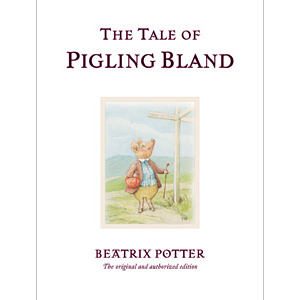 Clive James comments on this (in Cultural Amnesia) in his essay celebrating the eloquence of Beatrix Potter. He recalls how his own children were fascinated by slant and mysterious phrases such as ‘eight conversation peppermints with appropriate moral sentiments’ and ‘Alexander was volatile’ in The Tale of Pigling Bland (one of the great character names). James concludes that
Clive James comments on this (in Cultural Amnesia) in his essay celebrating the eloquence of Beatrix Potter. He recalls how his own children were fascinated by slant and mysterious phrases such as ‘eight conversation peppermints with appropriate moral sentiments’ and ‘Alexander was volatile’ in The Tale of Pigling Bland (one of the great character names). James concludes that
Children like to hear good things said a thousand times.
Tags: brain, children's books, writers
Posted in Children's Books, Reading, Science, Writing | No Comments »
Sunday, March 27th, 2011
As we dig deeper and deeper using scientific methods, we continue to find rational and meaningful order Paul Davies
 Still pondering the ‘mindful’ universe. It is ‘finely tuned’ to support life — indeed, it seems to be geared towards the creation of ‘mind’. Then there’s the question of meaning. Twelve leading scientists and thinkers were asked, Does the universe have a purpose? Five of them answered ‘Yes’, two said ‘No’, and the others were everywhere in-between (including one ‘I hope so’). Read their fascinating responses here. Jane Goodall’s personal response recalls a transcendent moment in a cathedral.
Still pondering the ‘mindful’ universe. It is ‘finely tuned’ to support life — indeed, it seems to be geared towards the creation of ‘mind’. Then there’s the question of meaning. Twelve leading scientists and thinkers were asked, Does the universe have a purpose? Five of them answered ‘Yes’, two said ‘No’, and the others were everywhere in-between (including one ‘I hope so’). Read their fascinating responses here. Jane Goodall’s personal response recalls a transcendent moment in a cathedral.
How could I believe that blind chance had led to that moment in time — the cathedral, the collective faith of those who had prayed and worshiped within, the genius of Bach, the emergence of a conscious mind that could, as mine did then, question the purpose of life on Earth Jane Goodall
I once heard the beautiful Monteverdi Choir in Pisa Cathedral (photo) – quite by chance, but hopefully not blind chance! It was a ‘moment in time’ for me, the voices lingering in the air long after the singing stopped…
Tags: mind, Paul Davies, science, Universe
Posted in Science, Universe | No Comments »
Thursday, February 3rd, 2011
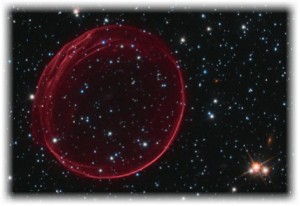
Photo: Mysterious cosmic egg (supernova): NASA Images
I love a good mystery: in my 20s it was the search for God; then family mysteriously absorbed 30 years; and now questions rise again: What is the purpose of life? What is quantum physics? Consciousness? And why am I always the one on the spot when the loo paper runs out?
I’ve cobbled together the following Great Mysteries (with much help from pop-science books):
Around 14 billion years ago (for motives which are unclear) matter gained an advantage over anti-matter and the universe became slightly biased towards life. But only a ‘mere- smear’ of the universe is ordinary matter – galaxies, elephants, us – the bulk is ‘dark stuff’ which is mysteriously connected to the rest. Matter is made of atoms, which are energetic, enigmatic little tykes. An electron inside an atom behaves like a two-year old – it seems to be everywhere at all times – but when humans give it some attention, its behaviour changes. Intriguing. The little grey cells (our brains) enfold another mystery: consciousness. So we’re able to find meaning in life: we can make up our own minds.
And now the story takes a twist, from science towards soul. Mystical biologist Charles Birch reckoned that the whole universe is made of ‘mind stuff’. He suggested that even electrons have a whiff of consciousness:
We exist only because of subtle connections between the very small and the very large.
It seems to be all about connection and meaning, and I admit I’m biased towards finding both – hopefully without scrambling the cosmic egg. But I’ll leave you with a more appealing metaphor, by poet Muriel Rukeyser (I’m off to buy loo paper).
The universe is made of stories, not atoms.
Tags: Charles Birch, consciousness, dark matter, electrons, mind, science, Universe
Posted in Science, Universe | 1 Comment »










 The EU has banned the nerve agent that has been contributing to honey bee decline around the world. The scientific evidence against these extremely toxic nicotine-based pesticides has grown steadily. Honey bees have contributed to our survival for the past 20,000 years and it’s time we showed them similar courtesy. These banned pesticides are still widely used on NZ crops (eg.corn) and sold to the public in garden centres (eg. the Confidor brand). Bee photo by Sophie Huber.
The EU has banned the nerve agent that has been contributing to honey bee decline around the world. The scientific evidence against these extremely toxic nicotine-based pesticides has grown steadily. Honey bees have contributed to our survival for the past 20,000 years and it’s time we showed them similar courtesy. These banned pesticides are still widely used on NZ crops (eg.corn) and sold to the public in garden centres (eg. the Confidor brand). Bee photo by Sophie Huber.







